New York Justice Delayed Is New York Justice Denied

Gov. Cuomo at church (Kevin P. Coughlin/Office of Governor Andrew M. Cuomo)
It has been nearly three years since Kalief Browder tragically ended his own life after being caged, abused, and tortured on Rikers Island. Elected officials promised us that his story would be a turning point and that New York would fundamentally transform a criminal justice system designed to criminalize low-income black and brown New Yorkers and then place a bounty, through the money bail system, on our freedom. With another new state budget now passed in Albany, it is clear state leaders are not going to make good on those promises and New York will continue to keep people locked in cages because they are too poor to pay bail.
I cannot imagine what Kalief must have felt while trapped in a cage, spending much of his time in solitary confinement, facing abuse from the guards and other incarcerated youth -- only there because he could not afford bail. As a young black person, growing up in Brooklyn, I can relate to how Kalief must have felt that night; his future was permanently disrupted. I have been out in my neighborhood, just enjoying myself, or hanging out with friends, only to have the NYPD initiate an interaction that reminds black youth we cannot afford to be care-free when the criminal justice system surveils, restricts, and criminalizes our very existence.
That is why I organize with youth across Brooklyn and New York City to end racist and biased policies and practices throughout the criminal justice system. It is why last week, I traveled three hours to Albany to join civil rights organizations, public defenders, community organizations, and NFL player DeMario Davis (formerly of the New York Jets), to demand New York legislators pass bail reform that will completely eliminate wealth-based detention, significantly reduce the number of New Yorkers caged before their trial, reduce racial disparities, end profiteering in pre-trial services, and does not increase the likelihood that people will be detected, detained or deported by federal Immigration and Customs Enforcement (ICE).
In Governor Cuomo’s State of the State speech he made promises to reshape New York’s bail and pre-trial detention that will “will transform our criminal justice system by removing critical barriers, reaffirming our beliefs in fairness, opportunity and dignity, and continue our historic progress toward a more equal society for all." He did not follow through by passing reforms that would have made positive change.
And, unfortunately, when I studied his proposals, it became clear some parts could actually bring reform in the wrong direction. If passed, the governor’s proposal would increase the number of New Yorkers who are detained before trial without the possibility of release, give prosecutors the power to hold New Yorkers before trial, expand the use of electronic monitoring and house arrests, and pass the costs of pre-trial services on to people awaiting their trial. It isn’t progress if we extend mass incarceration into our homes and communities through ankle bracelets and house arrests and then charge poor people for the cost of their release before trial.
A recent report from the New York Civil Liberties Union found that black New Yorkers are twice as likely as white New Yorkers to spend at least one night in custody on bail, and more than 90,000 New Yorkers spent a day or longer in custody on bail between 2010 and 2014. Kalief Browder was arrested in 2010. Eight years after his arrest and three years after his death, the turning point we were all promised seems farther and farther away.
With Governor Cuomo now celebrating the new budget and the state Legislature on vacation; and as we hit the 50th anniversary of the murder of Dr. Martin Luther King, Jr., we should all remind our elected officials that justice delayed is justice denied.
***
Nicshel Samedi is Youth Leader, Make The Road New York. On Twitter @MaketheRoadNY.
***
Have an op-ed idea or submission for Gotham Gazette? Email This email address is being protected from spambots. You need JavaScript enabled to view it.
State Budget Includes Unprecedented $175 Million to Invest in Skills - Now What?
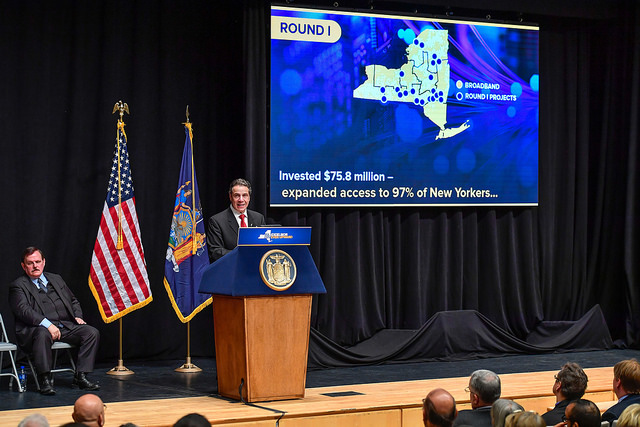
Gov. Cuomo (photo: The Governor's Office)
New research released last month by JobsFirstNYC and the Community Service Society found that more than 136,000 young adults 18-24 years old in New York City are not working and not enrolled in school. And despite increased enrollment, equity gaps in college completion have widened in New York City. Meanwhile, all of the employment gains for members of this age group over the last five years has been in low-wage, part-time work. But New York City’s young adults are not the only group facing barriers to enter and succeed in an increasingly more skilled labor market, as more than 40 percent of residents across the state only have a high school diploma or less in a time when employers are crying out for more trained workers.
Recognizing the urgent need to invest in human capital, Governor Cuomo put forward a promising vision that will put the state on a path to realizing the full potential of all New Yorkers and the Legislature worked with him to include it in a final budget deal (read Governor Cuomo’s Workforce Investment Plan is a Promising Start for overview of the governor’s original proposal). This is a victory for New Yorkers. The governor and the state Legislature should be applauded.
Included in the final New York State budget for the fiscal year that began April 1 is an unprecedented $175 million for workforce development, which will flow through a Consolidated Funding Application (CFA) process likely to begin as early as this spring. The final deal is not all that different from what Governor Cuomo proposed back in January and gives a great deal of autonomy to him to design and manage the CFA process and decide how best to allocate resources regionally. Because of the flexibility the executive chamber has, it’s safe to assume that the resources will be connected in some way to (and potentially managed out of) Empire State Development and the Regional Economic Development Councils, as was outlined in the governor’s original proposal. Wherever the CFA process ends up, the $175 million must be regionally-targeted, support multi-year strategies, and be available on a rolling basis.
The only real mandate by the Legislature included in the final budget deal is to work with the State Workforce Investment Board and the agencies that currently administer workforce development programs (New York Department of Labor, SUNY, CUNY, etc.). The legislation states: “Services and expenses for workforce development shall be administered in consultation with the state workforce investment board and state agencies responsible for administration of workforce development programs.”
In addition to establishing a CFA process to allocate the $175 million across the state, the governor also put forward three other workforce development proposals that were not part of adopted budget legislation. This includes establishing a New York State Office of Workforce Development, building a state-of-the-art data analytics infrastructure modeled after Monroe Community College’s, and creating a one-stop-shop online platform for job-seekers and employers. The good news for these initiatives is that the governor has the administrative authority to do them without the need to pass legislation.
The Legislature’s mandate to work with all the agencies that currently provide workforce development and training programs as well as to work in consultation with the state’s Workforce Investment Board to coordinate the CFA process should be treated as the first task of the soon-to-be-created New York State Office of Workforce Development. With $175 million of workforce development resources secured, this new office has a unique opportunity to create a responsive, 21st century workforce unleashing the full economic power of the state.
To realize this vision, Governor Cuomo must also charge the Office of Workforce Development to create a more integrated workforce development system that ensures there is dedicated state-funded revenue stream year-to-year and braids together existing funding streams for programs (TANF, SNAP E&T, WIOA, etc.) with similar goals, as well as establishes a shared framework for measuring outcomes. Additionally, this office must work across government to align the education, human services, economic, and workforce development systems. In doing so, the state will need to invest in demand-driven innovative ideas and partnerships to create a structurally adaptable and responsive workforce development system. Finally, this newly created office must make shared outcomes, accountability, and transparency the ‘new normal.’
Fortunately, Governor Cuomo and the soon-to-be named Director of the Office of Workforce Development does not need to do this alone. The Invest In Skills NY initiative—a diverse statewide coalition of employers, training providers, intermediaries, higher education institutions, professional and trade associations, young adult groups, and many others who make-up the workforce development system are ready to work to bring New York State’s labor force into the 21st century.
***
Kevin Stump is vice president of Policy, Communications, and In-School Practice at JobsFirstNYC and co-chair of the Invest In Skills NY Campaign. On Twitter @KevinStump and @JobsFirstNYC; #InvestInSkillsNY.
Let Carranza Lead
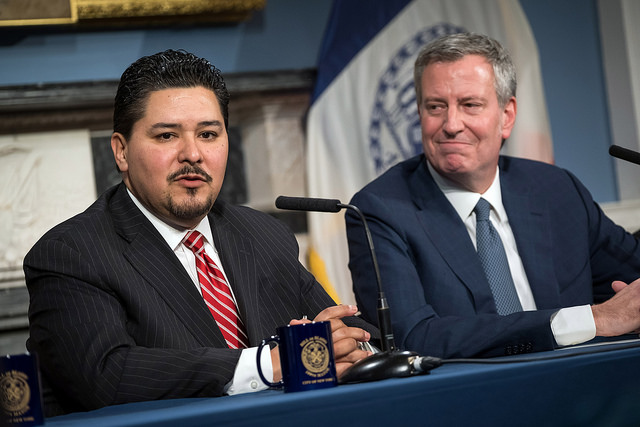
Mayor de Blasio and Chancellor Carranza (photo: Ed Reed/Mayor's Office)
According to press reports, Mayor de Blasio, First Lady McCray, and First Deputy Mayor Fuleihan were the key decision-makers in appointing our new schools Chancellor, Richard Carranza. They now must let Carranza lead.
De Blasio had worked with Carmen Fariña for decades, so her appointment was a no-brainer. But when it came to finding her replacement, his secretive process blew up. Alberto Carvalho, the mayor’s first choice, publicly repudiated the job after taking it, reportedly because City Hall attached strings to his hiring authority. The micro-managers are now doing the same to Carranza. It has to stop.
First, soon-to-be-former Chancellor Fariña appointed herself to some ambiguous job placating warring co-located schools. Then Aimee Horowitz, the senior administrator for the beleaguered Renewal Schools program, was transferred from that post to assist Fariña’s efforts.
Installing the old chancellor in another job and reshuffling other leadership positions before Carranza arrives belittles an already hobbled second-choice candidate.
Mayoral control should not mean that chancellors become lap dogs to political expediency. In setting an agenda of continuity from on high, the mayor is sacrificing educational improvement to claim his previous education agenda as the single path to quality.
That’s nonsense. Whatever Fariña’s accomplishments, the system has yawning failures. Barely 40% of 3rd through 8th graders are proficient in reading, fewer than 30% for black and Latino students according to 2017 state test scores. Citywide math scores are even lower, with only one in five black students meeting proficiency standards. Graduation rates stand at about 70%, but only half of grads are deemed “college ready.” Add to that severe shortfalls in educational attainment by students with disabilities, English language learners, and students experiencing homelessness, and the mayor’s rosy picture seems less about progress and more about his next campaign.
Leadership untethered from claims of “Mission Accomplished” is needed for further progress and mid-course corrections. This can’t be done by a mayor wedded to his own record.
First, of course, is giving Carranza the ability to select deputies who know the system but are answerable to him, not City Hall. Next, he needs to be able to speak out not as a ventriloquist’s dummy but as someone who has already led two urban school districts.
Carranza’s statement that there is “no daylight” between him and the mayor better not be true. We are not talking about the Sun God here. De Blasio is prone to mistakes and it is up to Carranza to push back when issues arise, as when he needs to take on the politically powerful teachers union in upcoming contract negotiations.
Then there are policy matters where the mayor needs to take a step back. Carranza actually used the word “segregation” at his initial press conference, something the mayor regularly avoids. Taking on the multiple achievement gaps left to him will mean confronting widespread enrollment issues that de Blasio has so far refused to tackle.
Coming from outside the system after a secret search, a runner-up already scarred by gender-bias allegations and mixed reviews of his previous experience, our new chancellor must bring new thinking and new energy to the table. De Blasio has already done him a disservice by cocooning Carranza, who faces great challenges. But the greater challenge is the mayor’s to let his hand-picked leader lead.
***
David C. Bloomfield is Professor of Educational Leadership, Law and Policy at Brooklyn College and The CUNY Graduate Center. On Twitter @BloomfieldDavid.
***
Have an op-ed idea or submission for Gotham Gazette? Email This email address is being protected from spambots. You need JavaScript enabled to view it.
Cynthia Nixon Should Avoid De Blasio’s Sham Progressivism
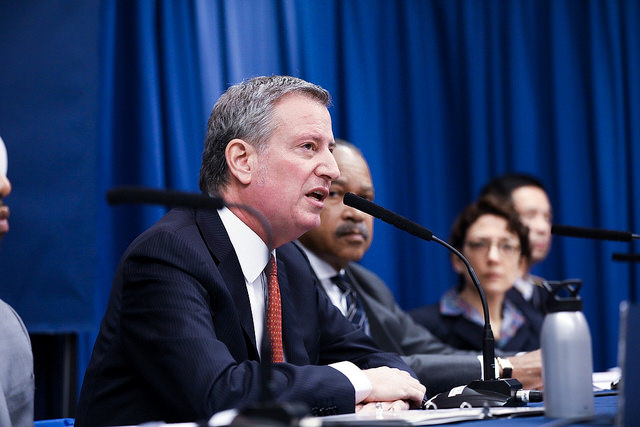
Mayor de Blasio (photo: Benjamin Kanter/Mayor's Office))
It is impressive that Mayor de Blasio has succeeded in wrapping himself in the progressive mantle despite the reality of his record. While his rhetoric stakes claim to that mantle, his record fails to merit the honor. As the old saying goes, actions speak louder than words -- or should, at least.
Perhaps it is additionally important now to scrutinize that record since it is commonly understood that Governor Andrew Cuomo's well-publicized challenger from the left, Cynthia Nixon, will campaign very much in the spirit of de Blasio's first mayoral run in 2013, which she intensely supported.
His policing policies alone, involving starkly racially-biased "broken windows" tactics, undercut the political identity that he seeks and that many journalists grant him. These practices target people of color daily for petty infractions that have been virtually decriminalized in white areas.
Relevant facts include: 85 to 95% of NYPD misdemeanor arrests involve New Yorkers of color, including 91% of marijuana possession arrests -- despite research findings that white people use and sell the drug in equal or greater proportions to African-Americans and Latinos -- and 91.5% of fare-beating arrests, which is the third most common NYPD arrest. About 95% of NYPD juvenile arrests involve black and brown youth. About 90% of persons confined on Rikers Island are African-American and Latino, and they are there for two main reasons: they're too poor to afford bail and an NYPD officer has arrested them.
A major area where de Blasio has failed to meet the needs of disadvantaged New Yorkers -- supposedly a key part of his base -- is our city's dual, related crises: homelessness and the lack of affordable housing. Again, facts: over 63,000 people live in our homeless shelters, an increase of about 13,000 since de Blasio took office; over 90% of our homeless families are African-American or Latino; and research shows that lack of affordable housing is the primary cause of homelessness.
De Blasio's most recent proposal regarding homelessness, made last year, entails opening 90 new shelters over the next five years with the modest goal of reducing the number of homeless people by 2,500. Possibly trying to trick us into thinking that the plan would have a significant effect, he called it "Turning the Tide on Homelessness." More like "Flying the White Flag of Surrender."
In 2014 de Blasio unveiled a plan to build or preserve 200,000 affordable housing units. He touts its success as a major progressive achievement of his first term. Yet even the city's own numbers show that the plan has not resulted in providing truly affordable housing for New Yorkers who need it most. The de Blasio administration has stated that the city has nearly 1 million households earning less than $42,000 per year, and we know that New York has only 425,000 units that these households can afford. Despite this shortfall, 80% of the so-called affordable units created in de Blasio's plan will be unaffordable for these low-income households.
A central problem is that de Blasio's plan artificially inflates what's considered "affordable," measuring a household’s eligibility by an Area Median Income (AMI) that includes all five boroughs and comparatively wealthy counties outside of the city: Westchester, Putnam, and Rockland. This card trick masquerading as fair practice opens the door for developers to build housing that ends up displacing families it supposedly serves.
On other liberal litmus test issues, de Blasio grades an “F.” He's failed to dismiss, as he has the power to, any of the officers whose reckless conduct contributed directly to Eric Garner's death; refused to include in the city budget money to support reduced or free subway and bus fares for poor New Yorkers -- instead, his police department arrests them; substantially ducked pressure to diversify our public schools, the country's third most segregated system; in response to credible charges that his administration engaged regularly in "pay-to-play" transactions benefitting major donors, promised to publish a list of wealthy contributors who received no government favors, then failed to do so; despite loud outcry by public defender groups, refused to provide legal representation to immigrant New Yorkers facing deportation convicted of felonies no matter how long ago.
De Blasio's record also exposes his tenuous relationship with facts. He's publicly repeated that the NYPD has ended most marijuana possession arrests, when last year it made 17,880. He claimed in donor appeals during last year's mayoral race that "special interests have spent $13 million to stop us." According to The New York Times, that figure includes $5.8 million that Uber spent in 2015 lobbying to beat back his attempt to limit the number of its cars on the roads. He claims New York as a "sanctuary city" despite his "broken windows" policing putting undocumented New Yorkers at risk of deportation daily.
De Blasio often states that he is the first Democrat elected New York City mayor in 20 years. It's a disingenuous point -- his predecessor Mike Bloomberg was a life-long Democrat who switched party affiliation to run for mayor in 2001 and who supported many standard liberal positions, such as on abortion, gay rights, gun control, and immigration. Even the notoriously law-and-order mayor from the ‘90s, Rudy Giuliani, backed most of those stances, too.
As the truth sets in, more New Yorkers see past the mayor's liberal rhetoric and recognize what his record reveals, that he is a mainstream, opportunistic politician. Cynthia Nixon, who's had an impressive early run out of the gate, confronts an important political call. To maintain her credibility as a progressive alternative to the governor, she must put some distance between herself and her old friend de Blasio.
For example, she must call for an end to biased and abusive "broken windows" policing and for dismissing the officers involved in the Eric Garner incident. She must promote free or reduced public transit fares for low-income New Yorkers and an aggressive plan to desegregate our public schools. She must call out and take on big real estate and propose an affordable housing plan that provides units that people living in poor communities can actually afford.
Finally, Nixon cannot lay a blanket charge of corruption just on Cuomo when evidence of "pay-to-play" governance has clearly tarnished the de Blasio administration. Taking such steps will increase her standing as an outspoken progressive with broad appeal for the voters likely to cast ballots in the Democratic primary in September. in addition to being strategic politically, it has the advantage of being the right thing to do.
**
Bob Gangi is the director of the Police Reform Organizing Project (PROP). On Twitter @GangiFromPROP.
***
Have an op-ed idea or submission for Gotham Gazette? Email This email address is being protected from spambots. You need JavaScript enabled to view it.
How the 21 in ‘21 Movement to Elect Women Will Be Successful
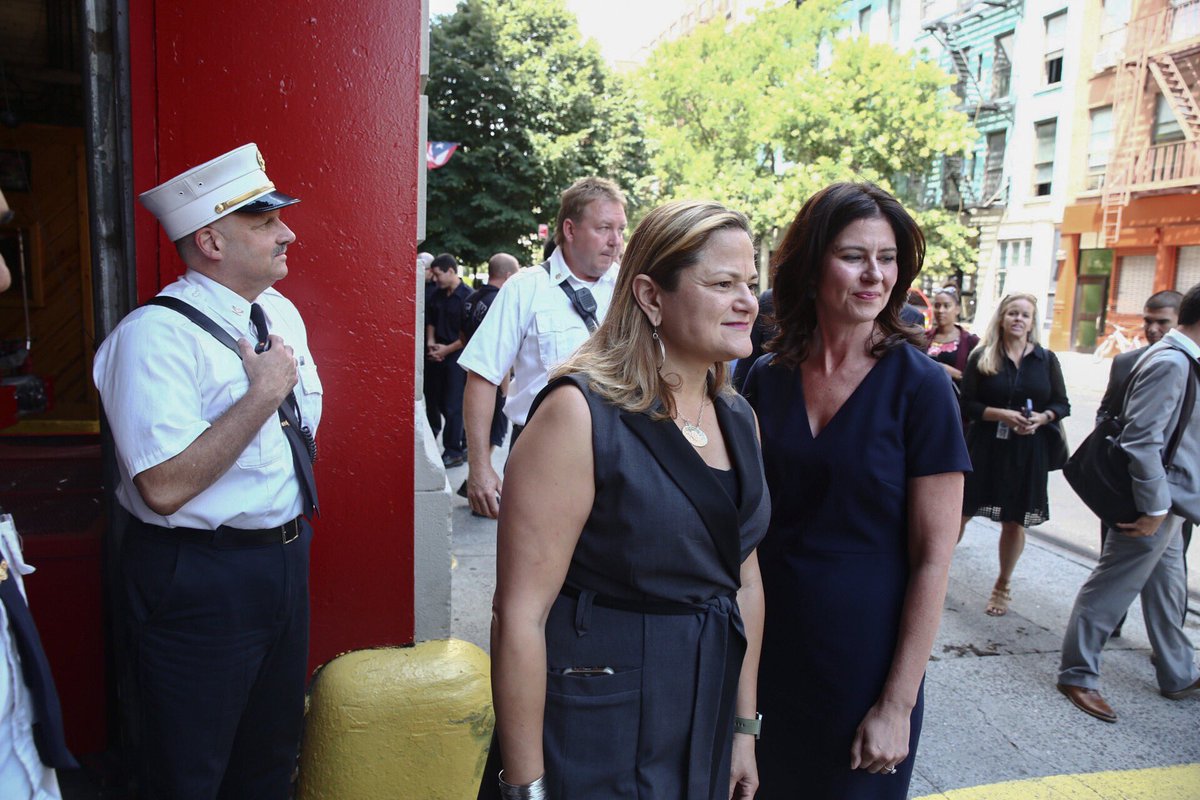
Mark-Viverito, left, and Crowley, the authors (photo: @NYCCouncil)
Susan B. Anthony said in 1897, “There will never be complete equality until women themselves help make laws and elect lawmakers.”
Thanks in part to Anthony’s life work and that of her fellow suffragettes, American women now have the power both to vote and serve as lawmakers. Yet, more than 120 years later, Anthony’s dream of complete equality has not been realized, because of the profound disparity in representation between men and women in elected office.
During our years as members of the New York City Council, we saw the number of women in the Council decline from a high of 18 in 2009 to its current number of 11.
Why should New Yorkers care about the underrepresentation of women in the city’s legislature? Our experience in the Council serving on the governing team that oversees the spending of your tax dollars is perhaps the biggest reason.
The city budget is over $85 billion and the Council has oversight over nearly 130 different government offices and agencies and nearly 300,000 full-time city employees. How this money is spent and these critical resources are managed reflects the makeup of the city’s elected officials. When over 78% of the Council’s members are men, male points of view dominate the discourse in the halls of government, even though a majority of New Yorkers—52%—are women.
Fortunately, there is a new awareness across the nation that women will not be equal until they have equal say in the most important decisions that affect their lives. One reason for this awakening is the election of a president who revels in his misogyny, has bragged about sexually assaulting women, and continues to show contempt for women in office, filling his cabinet with the highest percentage of men of any president since George W. Bush in his first term.
To do our part locally in the fight for complete equality, we co-founded the 21 in ’21 Initiative, a nonpartisan effort that aims to achieve gender parity in the New York City Council, starting by increasing the number of women in the Council to at least 21 through the next city election cycle, with votes cast in 2021.
While this goal is ambitious, it is attainable mainly because of two factors: term limits and the city’s campaign finance system, which includes a significant public matching fund program.
In 2021, 36 of the Council’s 51 seats will be vacant because of term limits. Without an incumbent office holder, these seats are much more winnable, particularly for a candidate who has spent years preparing to run. That’s why nearly four years out from Election Day, we’re already building the infrastructure and recruiting the candidates we’ll need to accomplish our mission of electing a minimum of 21 women to the Council in 2021.
It will be a challenge, but it is possible, and the work is well underway.
The best part of New York City’s electoral system is that you don’t have to be rich or have wealthy friends to become a successful candidate. That’s because the city’s Campaign Finance Board matches every dollar donated to your campaign up to $175 at a six-to-one ratio, turning, for instance, a $10 donation into $70. This system empowers women from every neighborhood and every background to step up and vie to represent their communities in the Council.
The main reason that more women aren’t elected officials is that far fewer women become candidates. Studies show that when women do run, they win at a comparable rate to men, despite additional barriers. While there are several factors that deter women from running, a large one is that women aren’t generally brought up in a way that inclines them to self-select as candidates the way men do.
We grew up in women-led households, in which our mothers made the decisions for our family. They were leaders that instilled in their daughters the belief that serving in public office was the noblest of professions. We were lucky to have mentors like our mothers.
It is this model of strong mentorship that is at the core of the 21 in ’21 Initiative. We have already built a top-notch network of mentors to strengthen and support female candidates.
21 in ’21 is here for the women ready to become the future leaders of our city, but all New Yorkers must contribute in order for Susan B. Anthony’s dream to become a reality. From the voting booth to our block associations, and our political clubs to our community boards and of course to the New York City Council and beyond, we must all demand equal representation now.
***
Melissa Mark-Viverito and Elizabeth Crowley are former City Council members and co-founders of 21 in ‘21. Mark-Viverito was the Council Speaker from 2014 through 2017. On Twitter @MMViverito and @ElizCrowleyNYC.
***
Have an op-ed idea or submission for Gotham Gazette? Email This email address is being protected from spambots. You need JavaScript enabled to view it.
For Government, It's DSO or Die
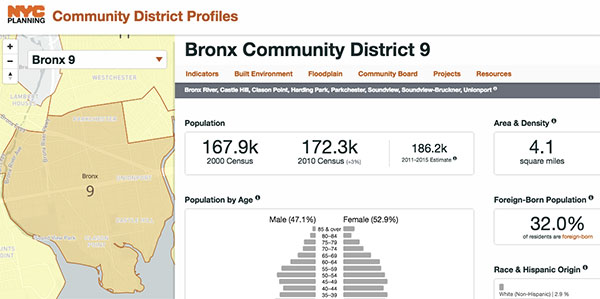
City Planning's Planning Labs
Private sector innovations in information technologies are transforming virtually every industry, and the rate of change seems to be accelerating. A decade ago, Facebook was a website used almost exclusively by college students to keep in touch with each other; today it’s one of the world’s largest media distributors with the capability of swaying elections simply by tweaking its algorithms; and in ten years it’ll likely be directing a self-driving car to drop you off at your friend’s house.
The mindblowing rate of innovation taking place in the private sector is a stark contrast to the glacial pace of innovation in government bureaucracies. Indeed, to many people in the private and public sectors, government agencies appear, at best, frozen in time, and at worst, actually deteriorating before our very eyes. New York City’s beloved subway system is a case in point.
It doesn’t have to be this way. Government agencies can leverage new tools, techniques and technologies to improve their effectiveness and even delight their users, but doing so requires more than simply signing a fat contract with a vendor of high-tech wares. It requires government adopting the values of the “open source way”: open exchange, participation, rapid prototyping, meritocracy, and community building.
Doing so will change government agencies in significant ways: new roles, new skills, new trainings, new people, and new organizational structures.
It’s easy to see why wholesale reform of government agencies isn’t happening: people don’t want to lose their jobs. But piecemeal reform is taking place within government, and patterns are emerging that show how small teams within government that deliver “digital services” to other government units and agencies - things like websites, mapping systems, workflow management solutions and other high-tech products and services - are driving change.
The major factor that distinguishes these newly emergent “digital services organizations” (DSOs) from other technology groups within government is that their main job isn’t procuring software from large software companies, but instead to leverage open source software, peer to peer collaboration methodologies, and agile development approaches to build their own products.
The origins of the “digital service” concept can be traced back to 2010 when the government of the United Kingdom began a website redesign project that turned into something much more: a rethinking of the very nature of government. Mike Bracken, co-founder of the U.K.’s Government Digital Services (GDS), articulated “government as a platform” in his 2014 PDF talk. GDS has gone on to become a vocal advocate of the open source way in government and is responsible for saving the UK Government over £1 billion a year since its inception in 2013.
The United States federal government got serious about starting a GDS-style entity in 2013 when the Obama administration realized that its hallmark legislative achievement, the Affordable Care Act, could be jeopardized by its inability to successfully launch the HealthCare.gov website by the time the legislation came into effect.
Once it became clear that the project was massively mismanaged, the administration assembled a crack team of technologists from inside and outside government to get the website up and stable. To achieve this goal, the team used many open source and agile development methodologies popular in startup culture. Ultimately they got the site launched, and many of the people involved went on to create and lead high-tech units in the government such as the U.S. Digital Service in the White House, and “18F” within the General Services Administration.
18F “collaborates with other agencies to fix technical problems, build products, and improve how government serves the public through technology.” Its process relies on open source and startup-centric principles of “human centered design, agile methods and open technology.”
This approach is very different than the “monolithic procurement” approach that usually happens within government where “large, complex, multi-year contracts” are drawn up between government agencies and large corporations. “According to the Standish Report from 2003-2012, 94 percent of government software projects over $10 million are either over budget, over time, or just don’t work,” via the 18F website.
Instead of monolithic procurement, 18F and other DSO advocate for in-house open source development and modular procurement, which is “a strategy that breaks up large, complex procurements into multiple, tightly-scoped projects to implement technology systems in successive, interoperable increments.” By pairing this with open source software development and meticulous documentation, 18F can share the innovations they develop for one agency with others, reducing costs for everyone involved and allowing anyone in the world to use and contribute code to their projects.
This approach has been highly successful. In less than four years, 18F has grown to nearly 200 staff and completed hundreds of projects for over 25 federal agencies that range from building public websites (like FEC.gov) to backend infrastructure (like Cloud.gov) and a myriad of products that help other government workers build faster, more accessible, and more secure technology products. They’ve been successful to the point where for-profit software industry groups lodged an official complaint that 18F was hurting their businesses because they were saving the federal government too much money.
The significance of 18F’s accomplishments, along with the clarity of their message about how to reform government, has gone almost entirely unnoticed by nearly everyone, except for a small but very online group of people who self-identify as “civic technologists.” This community consists mostly of people who work as technologists for private enterprise by day, and try to use their technical skills to more broadly help people by night. Rarely do these people actually work within government, and if they do, it’s rarer still for them to have the freedom and support within government to perform the type of work that 18F does.
While there are a number of federal entities that have adopted the DSO model such as Defense Digital Service, which applies 18F-style approaches across the Department of Defense, at the municipal level there are very few: San Francisco has a small digital services team, and the teams managing websites in Boston and Philadelphia have some DSO characteristics, but New York City Department of City Planning’s Planning Labs follows the 18F model most closely.
Planning Labs is a nine-month-old, three-person unit within DCP that isn’t shy about borrowing from 18F’s playbook. Its site is built with 18F code, its published principles are nearly identical, and its members’ outspoken support for open source as the path forward for government is just as loud.
In its short existence, its already launched a half-dozen products, each of which uses open source approaches to deliver a standardized product. Looking through its portfolio of products - from its zoning tool, facilities directory, tax lot viewer, and statistical mapping tool - it becomes clear that Labs isn’t simply building products, but instead organizing the city’s information in an open, standardized, and future-friendly way that will benefit New Yorkers for generations. It’s not hard to imagine these various systems being weaved together along with other open source solutions such as David Moore’s City Council tracking system Councilmatic to create a comprehensive city information system like SimCity, but real, and in real-time.
For Chris Whong, Planning Lab’s founder, NYC Planning Labs “is responding to the need to create more functional and accessible tools for planners, practitioners, and the general public to use and analyze data. With a smaller team, human-centered design, agile processes, and open source software, we are delivering tech products better, faster, and cheaper in-house.”
Whether one thinks government is good or bad, or somewhere in between, almost everyone agrees that it should work effectively, operate transparently, and if it’s going to provide services to the public, they should be of decent quality and at a reasonable costs. The capacity for government to deliver services, and the public’s desire to pay taxes to fund government agencies to provide them, is heavily dependent on the effectiveness of government agencies and the civil servants that work within them.
In an age of rapid private sector innovation, those agencies and civil servants will need to be able to leverage technology effectively if they want to keep up with their private sector counterparts. If they don’t, the public will want to privatize these services. It’s that simple.
The “do or die” nature of this moment can’t be overstressed enough. If DSOs like 18F and Planning Labs aren’t given the resources and flexibility they need, their members will become dejected and find happier homes in a private sector that values their talents.
Anyone who is passionate about good government, anyone who thinks the public sector is important and worth preserving, should be studying and supporting DSOs and the principles that they follow. If they aren’t the future of government, it’s possible nothing is. Such is the sentiment of Matt Brackin, the co-founder of the U.K.’s GSA, who recently tweeted: “I hoped the internet era would revitalise our state. It's just exposed its bankruptcy.”
***
Devin Balkind is a technologist and nonprofit executive who works on civic technology projects in New York City through Sarapis Foundation and on humanitarian projects around the world through Sahana Software Foundation. He was a candidate for New York City Public Advocate in 2017. On Twitter @DevinBalkind.
***
Have an op-ed idea or submission for Gotham Gazette? Email This email address is being protected from spambots. You need JavaScript enabled to view it.
Don’t Pass a State Budget Without Investment in Human Services

(photo via @UNHNY)
Poverty-related issues such as homelessness or family crisis treatment like opioid addiction need more than a simple infusion of cash. Addressing the underlying issues and building community resilience requires long-term, community-based organizations dedicated to ensuring that families and individuals have access to local programs that address the stability of their communities.
State government appreciates this expertise as it contracts with human service organizations to deliver programs on its behalf, but government leaders fail to provide the funding necessary to fully support the organizations’ long-term stability. Unfortunately, state contracts rarely cover the full cost of human services, which has resulted in a chronically underfunded sector with crumbling infrastructure and an undercompensated workforce. The absence of adequate funding directly undermines the long-term stability of this sector, which undermines the short- and long-term stability of its workforce and clients.
Employees in the nonprofit human services sector are poorly compensated, despite their experience and education — 41% percent have a four-year college degree and another 25% have some college education. As a result, these dedicated workers often find themselves relying on government benefits to support their own families. Low wages drain talent from our sector as the workers with experience move on to find jobs that provide better compensation. Employee turnover undermines human services programs, which are best served by a stable workforce, whose members earn the trust of their clients and can most effectively help them.
The human services sector vigorously supported Governor Cuomo’s efforts to increase the minimum wage, but we were disappointed when our sector’s contracts were never adjusted by the state to fund the wage increases for human services employees. Unlike for-profit businesses, nonprofit human service organizations cannot increase the cost of their services to pay for higher wages. These increased wages must be paid for by the state.
The governor and state Legislature are currently negotiating the new budget for the state fiscal year that beings on April 1. We have joined a statewide coalition of 350 nonprofit human services providers, Strong Nonprofits for a Better New York, in order to call on the state to make key investments to strengthen the human services sector.
One of our key requests is that the state fund the minimum wage for human service contracts, so that we can provide much-needed salary increases for this workforce.
Outdated infrastructure is also a major concern among nonprofit organizations.
Building repairs and technology upgrades are not included in contracts, yet are essential to running quality programs. The state created the Nonprofit Infrastructure Capital Investment Program (NICIP) to address this issue, but, unfortunately, current funding levels are not sufficient to support current needs. Hundreds of nonprofits have applied for a very limited number of grants and we call on state leaders to add funding to NICIP to support these outstanding grant applications.
Without these critical investments in our workforce and capital for our facilities, nonprofit human services organizations will be forced to serve fewer families, children, immigrants, and older adults in the coming year. The New York State Assembly has included these items in its budget priorities and now we need the governor and the State Senate to support funding the minimum wage and continuing to fund infrastructure.
Without this investment it will be our communities that ultimately suffer.
***
Susan Stamler is the Executive Director of United Neighborhood Houses, an association of settlement houses that reaches more than 750,000 New Yorkers each year. On Twitter @UNHNY.
***
Have an op-ed idea or submission for Gotham Gazette? Email This email address is being protected from spambots. You need JavaScript enabled to view it.
Attacks on Yeshivas Present a Dangerous Slippery Slope
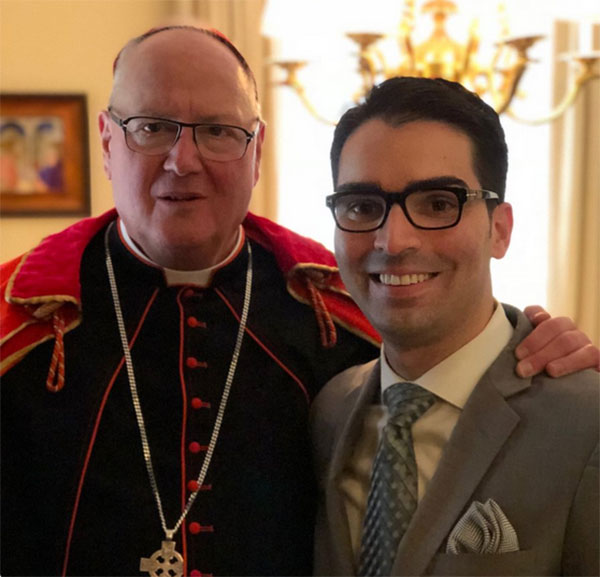
Eric Ulrich, the author, right, and Cardinal Dolan (photo: @eric_ulrich)
In the coming months, the city and state education departments are expected to rule on an issue that may have huge repercussions for parental school choice and religious freedom. A small group of former yeshiva graduates have alleged that religious schools in Orthodox Jewish communities are failing to provide adequate education to students. As an avid supporter of parental choice, I worry education leaders will side with these critics, posing a threat to private schools well beyond the Jewish community.
Many years ago, I attended P.S. 63, an elementary school in Queens. My mother, a single parent and devout Catholic, made the decision to transfer me to the former Nativity of the Blessed Virgin Mary School, a Catholic elementary school. She wholeheartedly believed Catholic school was a better environment for me at the time – and it was. Appreciative of the opportunities Catholic school afforded me, I continued my religious education at Cathedral Prep Seminary High School.
As the product of both public school and Catholic school education, I recognize the importance of parental school choice. The values instilled in me through my religious upbringing and education paved the way for my career as a public servant. Attending Catholic school ignited my passion for helping people; and at one point in my life, I seriously contemplated becoming a priest. If my mother did not have the freedom to enroll me in the school of her choice, I might not have taken the path I’ve taken, which I have found extraordinary fulfilling.
During my time in office, I have visited many yeshiva schools. In each of those visits, I saw a vibrant atmosphere. It is clear to me the Orthodox community takes education seriously. The school day begins just after sunrise, and the majority of yeshiva students study long after they are dismissed. Their studies are deeply rooted in the Torah and Talmud, which encourage discussion and debate at a very young age. Their studies focus heavily upon religious and legal texts, and teachers employ a method of Socratic dialogue with students more commonly found at law schools. That may not be a familiar experience for graduates of traditional secular schools, but tens of thousands of parents choose these schools each year because yeshivas have served them – and their families – well for generations.
The narrow issue before officials is whether these yeshivas are adhering to a vague state regulation requiring private schools to provide a substantially equivalent education to that of public schools. What that means in practice is enormously subjective; private and religious schools throughout the state are awaiting the results of a looming “clarification” from the State Education Department with deep trepidation.
Government officials are being subjected to a pressure campaign by anti-yeshiva activists, who continuously attack the Orthodox Jewish community under the guise of educational quality. We must continue to protect freedom of religion and the rights of parents to send their children to religious schools – whether they are Catholic, Islamic, or Jewish. If we do not stand-up for yeshivas today, the future of other private schools may be next.
***
Eric Ulrich is a City Council member representing parts of Queens. On Twitter @eric_ulrich.
***
Have an op-ed idea or submission for Gotham Gazette? Email This email address is being protected from spambots. You need JavaScript enabled to view it.
I’m a NYCHA Resident Who Supports Private Investment in Public Housing

(photo: @NYCHA)
After a harsh winter during which hundreds of thousands of NYCHA residents suffered without heat and hot water at one time or another, many people across our city have been asking a simple question: do public housing residents deserve the same quality of life as everyone else?
The answer is obvious: of course we do. Better yet, there is a clear path to make that a reality, and soon.
The fact is that just a miniscule fraction of New Yorkers living in public housing enjoy the benefits of private management and well-funded maintenance operations. Hundreds of thousands of our fellow citizens do not – and they are bearing the burden of a system that faces a $25 billion deficit, with little hope for anywhere near enough federal funding on the horizon.
Around 320,000 of those residents went without heat or hot water at certain points this winter, often during the coldest stretches – and now New York must take action to ensure that this cannot happen again. Public-private partnerships will improve the living conditions of NYCHA families, and it is time for more of those agreements. Not next year, not in two years, not in three years. Now.
It is no secret that urging public-private partnerships for NYCHA is politically challenging – and I was once skeptical of these arrangements myself. But if that kind of collaboration means being able to ensure that every NYCHA family has heat when they most need it – and let’s be clear that this is exactly what is at stake here – then public-private partnerships are not a problem, as some critics have said, but are instead part of a solution.
I am a resident leader of a NYCHA building that has already benefited from this kind of work. I have firsthand understanding of the type of progress that is possible from these partnerships. Simply put, I am living in a success story every day, but my heart is breaking for the hundreds of thousands of residents still struggling underneath the weight of a broken system.
In 2014, NYCHA engaged in a public-private partnership at several Section 8 developments across the five boroughs – totaling nearly 900 homes including my building, Campos Plaza I – because of the potential benefits it could provide for families. Despite what skeptics said at the time, it turns out that they were absolutely right.
This winter, our building had the heat and hot water it needed. We got to cook in renovated kitchens. And, this spring, we will enjoy our playgrounds and other open space. Our rents did not increase, and we all feel secure in our homes because we know that NYCHA still has ultimate control of our building and retains the power to remove the private partner should it ever want to do so.
At a time when city funds are stretched so thin and federal funds are unlikely to arrive, these positive changes did not come from the wave of a magic wand. They exist because of resources made available through a public-private partnership that provided the necessary investment in our apartments.
It is, at the end of the day, a really simple concept: when there are not enough public dollars to ensure that NYCHA buildings receive the maintenance and renovations they need, public-private partnerships can fill those gaps and give residents like me a better quality of life.
It was encouraging to see NYCHA move forward on another public-private partnership to leverage private financing at its Ocean Bay complex in Bayside. At that nearly 1,400-unit development, which was battered by Hurricane Sandy and remained in dire need of improvements, the deal generated an additional $560 million in financing for better buildings and new infrastructure. Families in Ocean Bay, too, understand what is at stake.
And of course it goes without saying that NYCHA residents believe that the federal government should invest more in public housing. But the reality today is that we cannot yet expect significant federal dollars to come – and that is simply no reason to deny my fellow residents the same quality of life I get to enjoy.
So, yes, those of us living in public housing do deserve the same quality of life as those living in private housing – but all of us, not just a lucky few. All of us deserve a decent, comfortable home. The tools are out there, it is now up to elected officials to make that a reality by encouraging more private-partnerships across New York City.
***
Dereese Huff is the resident association president at NYCHA’s Campos Plaza I.
***
Have an op-ed idea or submission for Gotham Gazette? Email This email address is being protected from spambots. You need JavaScript enabled to view it.
Trump Administration Attacks on Title X Could Result in Even More Deceptive Women’s Health Clinics
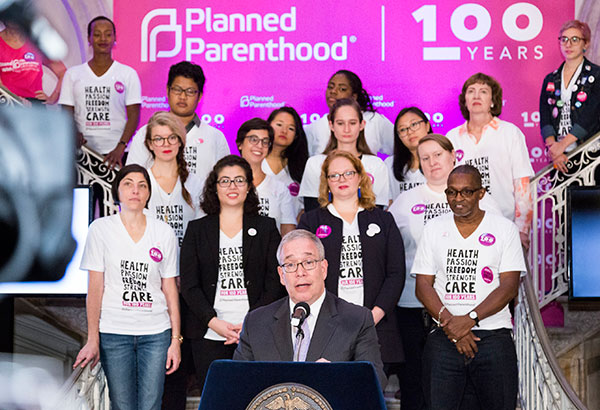
Comptroller Stringer with Planned Parenthood (photo via @NYCComptroller)
The Trump-Pence administration just took aim at the Title X program—the nation’s long-standing program for affordable birth control and other sexual and reproductive health care that more than four million people nationwide, including 150,000 New Yorkers, rely on each year.
The administration issued a new call for funding applications that radically changes the program's priorities—and that will shift funding away from expert sexual and reproductive health care providers, to anti-abortion crisis pregnancy centers that masquerade as legitimate health care facilities solely to shame and mislead pregnant individuals about their reproductive health options.
There’s no denying it: This is all part of a coordinated attack on access to accurate sexual and reproductive health care information—and to access to birth control and safe, legal abortion.
The attacks don’t stop there. On Tuesday the Supreme Court heard its first major reproductive rights case since the confirmation of Justice Neil Gorsuch, Trump’s anti-abortion appointee—and the case could also change how crisis pregnancy centers operate. It will determine whether crisis pregnancy centers will be allowed to continue to lie to people about their reproductive health care options by calling it First Amendment promoted speech.
Let’s be clear – we must fight back against these attacks to ensure that New Yorkers, especially those with low incomes, continue to have the fundamental health care they need and deserve.
Since 1970, the government has awarded Title X grants to sexual and reproductive health care providers that offer contraception, STI testing, cancer screenings and more to help uninsured and underinsured individuals afford them. Historically, Title X is meant to ensure that every person—regardless of where they live, how much money they make, their background, or whether or not they have health insurance—has access to basic, preventive sexual and reproductive health care. This program is a critical safety net for many people who would otherwise go without health care, like those in low-income communities and communities of color who disproportionately face barriers to care.
When programs like this are under attack, it’s our most marginalized communities and at-risk families who stand to suffer the most. As a recent report by the New York City Comptroller’s Office showed, in 2015, 91 percent of people served under Title X throughout New York State were women, and 60 percent had incomes at or below the federal poverty line. Nearly one-third were uninsured.
The U.S. Department of Health and Human Services’ new guidelines for Title X would push these patients to go to facilities that emphasize abstinence-only ideology and that do not offer the full range of birth control options. The new guidelines are designed to roll back access to highly effective forms of birth control, like long-acting reversible contraceptives (IUDs and implants).
These guidelines also clearly open the door to anti-abortion fake clinics participating in the program, even though they use deceptive tactics such as providing medically inaccurate information to women, including lying about the gestational age of a pregnancy in order to make it harder for someone to access an abortion.
Already, throughout New York City, crisis pregnancy centers masquerade as legitimate health care facilities solely to shame and mislead pregnant individuals about their reproductive health options and prevent them from seeking abortion care. The new Title X guidelines could result in these fake clinics receiving taxpayer dollars and expanding, targeting even more people who are seeking legitimate reproductive health care services. These misleading anti-abortion facilities may continue to exist—but we shouldn’t be supporting them with federal taxpayer money.
This egregious attack on Title X is an attack on women and vulnerable communities, and on the rights of New Yorkers to make the health decisions best for them and their families.
All New Yorkers should have control over their sexual and reproductive lives. This includes the decision of whether, when, and how to have children, how to practice healthy and respectful sexuality, how to protect ourselves and our partners against STDs, and more. When we make our own decisions about our bodies and our health care, we determine our own futures. And when our reproductive autonomy is under threat, so too is our collective health and well-being as a community and as a city.
We will do everything we can to ensure that all people are empowered to take control of their health and their futures. We see the hostile agenda coming from Washington to take away our basic freedoms and target our most vulnerable communities, and we are ready to fight for you and with you every step of the way.
***
Scott M. Stringer is the New York City Comptroller. Laura McQuade is President and CEO of Planned Parenthood of New York City. On Twitter @NYCComptroller and @PPNYCAction.
***
Have an op-ed idea or submission for Gotham Gazette? Email This email address is being protected from spambots. You need JavaScript enabled to view it.
When Lawmakers Fail on Gun Sense, Generation Z Steps Up
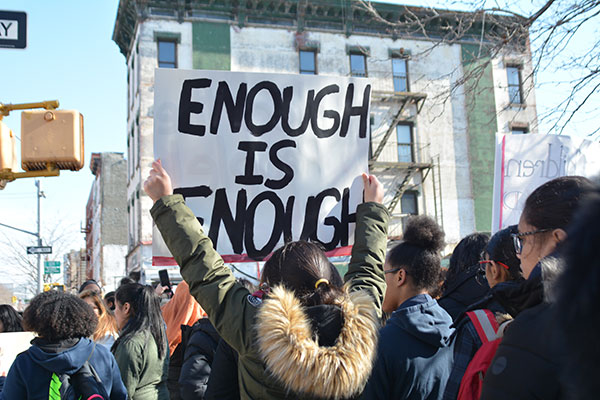
(photo: Cristina Gonzalez)
We were 12 years old when 20 children and six adults were gunned down in Sandy Hook Elementary School. One might think this a bit young to be exposed to such a raw act of violence, and experience this shift where gun violence was now becoming an American norm. We felt lucky to be living in a state where gun laws were strict and fairly well-regulated. But Sandy Hook hit us both hard. To hear about a school full of innocent children being targeted, our stomachs turned over in grief and disgust, and our eyes were opened to an entirely unfamiliar world of hatred and distrust in our government.
The ability to own guns in this country is a result of our Second Amendment. A law written in the 18th century when our government was still fresh and new, we had just won our war against England and were planning on beating back any possibility of invasion. At the time, this law made sense. Our citizens had land to defend, and we wanted to be sure our central government didn’t abuse their power and create an oppressive regime. All these reasons made the Second Amendment perfectly reasonable at the time. Now, 227 years later, the original intentions of our Founding Fathers have come to be interpreted by some as an absolute, unflinching freedom to bear arms, for almost everyone of almost every kind of weapon -- even when those arms are not in any way necessary in the day-to-day lives of Americans or likely be used to fend off invaders or an overreaching government.
We want to preserve people’s rights and freedoms, though some might assume our position intends to infringe on that. For so many years, we have had to rely on our elected representatives, and the interest groups and lobbyists linked to Congress, to make real, national change on our behalf. They have failed us.
Our next congressional election is this coming November. With 470 seats up for grabs, and more than 2,400 candidates running, as newly-minted voters we realize that this fall we get the opportunity to choose who goes into those seats. We no longer have to put our trust into the people who have been letting us down and neglecting our safety year after year. Having the lives of American children threatened constantly, and the impending fear of possibly being the next victims of gun violence, has driven us to step up, and speak to our generation to finally make a call to action.
We first took steps to make sure that the March 14 walkout was not only happening in our schools but in others across the city. We provided students that didn’t have the resources or the ability to plan their walkouts with step-by-step instructions on how to conduct their own walkouts so they could make them as effective and powerful as possible while still remaining safe. In this process we found each other and together we created a platform we call Generation Z.
We’ve gathered over 2,000 kids and counting across the Greater New York Area in over 20 different schools and counting to ensure the work doesn’t end with the walkouts.
We have been working on policy points related to gun reform that need to be put in place, including the full implementation of background checks; the removal of military grade weapons and high capacity magazines; preventing teachers from being armed in schools; stricter regulations that would prevent the trafficking of guns into our state; better reporting of domestic violence convictions and enforcement of current laws barring those convicted of domestic violence offences from owning guns; and the removal of metal detectors, specifically within schools in communities of color, and replacing them with better school mental health departments.
We want Generation Z to be the platform we never had, and we don’t want to stop with the walkouts. We continue to raise money to go to Washington, D.C. to be heard on Capitol Hill. We want Generation Z to tackle the problems that we never had the opportunity to voice ourselves. We hope to gain the support of the adults in our communities, especially those with the means and privilege to help, to fulfill our mission to travel to Capitol Hill and to advocate for, and implement, much-needed change. We plan to show other young adults how to exert their power as voters and ensure progress is made. We are the future. We will be heard. We are Generation Z.
***
Amanda Delaney and Ella Marion are members of Generation Z. On Facebook: Generation Z for Gun Reform and on Instagram: @genz4gunreform.
***
Have an op-ed idea or submission for Gotham Gazette? Email This email address is being protected from spambots. You need JavaScript enabled to view it.